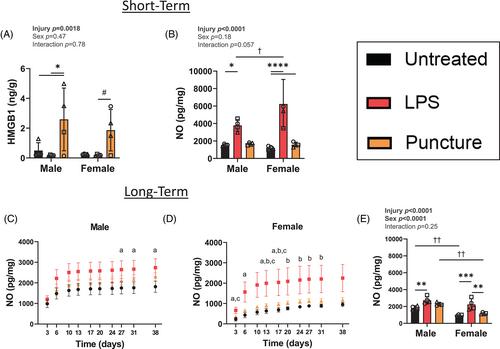Sex differences in the biomechanical and biochemical responses of caudal rat intervertebral discs to injury
Abstract
Background
Intervertebral disc degeneration (IDD) is a major cause of low back pain (LBP) worldwide. Sexual dimorphism, or sex-based differences, appear to exist in the severity of LBP. However, it is unknown if there are sex-based differences in the inflammatory, biomechanical, biochemical, and histological responses of intervertebral discs (IVDs).
Methods
Caudal (Coccygeal/Co) bone-disc-bone motion segments were isolated from multiple spinal levels (Co8 to Co14) of male and female Sprague–Dawley rats. Changes in motion segment biomechanics and extracellular matrix (ECM) biochemistry (glycosaminoglycan [GAG], collagen [COL], water, and DNA content) were evaluated at baseline and in response to chemical insult (lipopolysaccharide [LPS]) or puncture injury ex vivo. We also investigated the contributions of Toll-like receptor (TLR4) signaling on responses to LPS or puncture injury ex vivo, using a small molecule TLR4 inhibitor, TAK-242.
Results
Findings indicate that IVD motion segments from female donors had greater nitric oxide (NO) release in LPS groups compared to male donors. HMGB1 release was increased in punctured discs, but not LPS injured discs, with no sex effect. Although both male and female discs exhibited reductions in dynamic moduli in response to LPS and puncture injuries, dynamic moduli from female donors were higher than male donors across all groups. In uninjured (baseline) samples, a significant sex effect was observed in nucleus pulposus (NP) DNA and water content. Female annulus fibrosus (AF) also had higher DNA, GAG, and COL content (normalized by dry weight), but lower water content than male AF. Additional injury- and sex-dependent effects were observed in AF GAG/DNA and COL/DNA content. Finally, TAK-242 improved the dynamic modulus of female but not male punctured discs.
Conclusions
Our findings demonstrate that there are differences in rat IVD motion segments based on sex, and that the response to injury in inflammatory, biomechanical, biochemical, and histological outcomes also exhibit sex differences. TLR4 inhibition protected against loss of mechanical integrity of puncture-injured IVD motion segments, with differences responses based on donor sex.


 求助内容:
求助内容: 应助结果提醒方式:
应助结果提醒方式:


